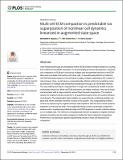Multi-cell ECM compaction is predictable via superposition of nonlinear cell dynamics linearized in augmented state space
Author(s)
Kim, Min-Cheol; Asada, H. Harry
DownloadPublished version (2.874Mb)
Publisher with Creative Commons License
Publisher with Creative Commons License
Creative Commons Attribution
Terms of use
Metadata
Show full item recordAbstract
Cells interacting through an extracellular matrix (ECM) exhibit emergent behaviors resulting from collective intercellular interaction. In wound healing and tissue development, characteristic compaction of ECM gel is induced by multiple cells that generate tensions in the ECM fibers and coordinate their actions with other cells. Computational prediction of collective cell-ECM interaction based on first principles is highly complex especially as the number of cells increase. Here, we introduce a computationally-efficient method for predicting nonlinear behaviors of multiple cells interacting mechanically through a 3-D ECM fiber network. The key enabling technique is superposition of single cell computational models to predict multicellular behaviors. While cell-ECM interactions are highly nonlinear, they can be linearized accurately with a unique method, termed Dual-Faceted Linearization. This method recasts the original nonlinear dynamics in an augmented space where the system behaves more linearly. The independent state variables are augmented by combining auxiliary variables that inform nonlinear elements involved in the system. This computational method involves a) expressing the original nonlinear state equations with two sets of linear dynamic equations b) reducing the order of the augmented linear system via principal component analysis and c) superposing individual single cell-ECM dynamics to predict collective behaviors of multiple cells. The method is computationally efficient compared to original nonlinear dynamic simulation and accurate compared to traditional Taylor expansion linearization. Furthermore, we reproduce reported experimental results of multi-cell induced ECM compaction.
Date issued
2019-09-20Department
Massachusetts Institute of Technology. Department of Mechanical EngineeringJournal
PLoS one
Publisher
Public Library of Science (PLoS)
Citation
Mayalu, Michaëlle N., Min-Cheol Kim and H. Harry Asada. "Multi-cell ECM compaction is predictable via superposition of nonlinear cell dynamics linearized in augmented state space." PLoS one 15 (2019): e1006798 © 2019 The Author(s)
Version: Final published version
ISSN
1553-7358
Keywords
Ecology, Modelling and Simulation, Computational Theory and Mathematics, Genetics, Ecology, Evolution, Behavior and Systematics, Molecular Biology, Cellular and Molecular Neuroscience